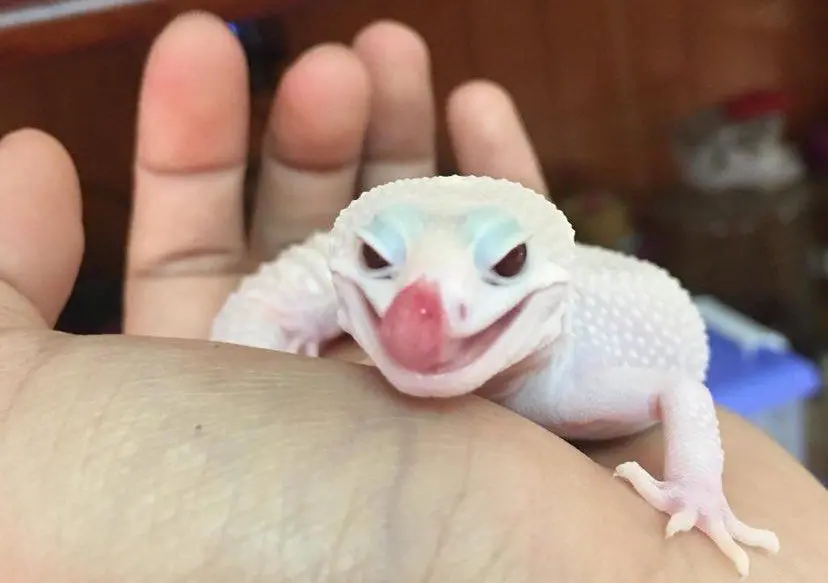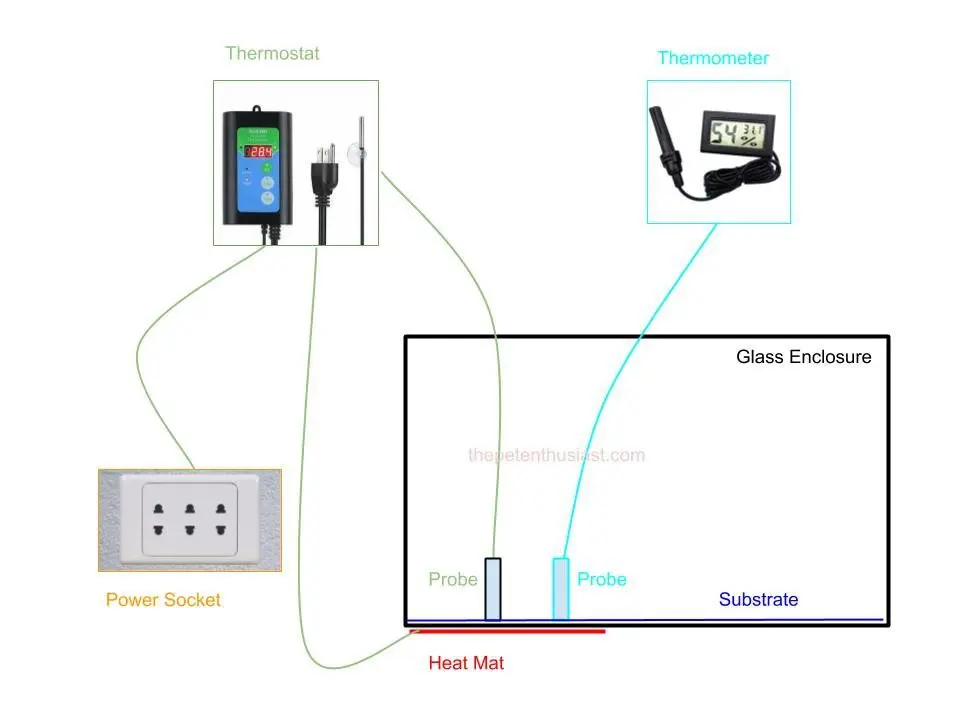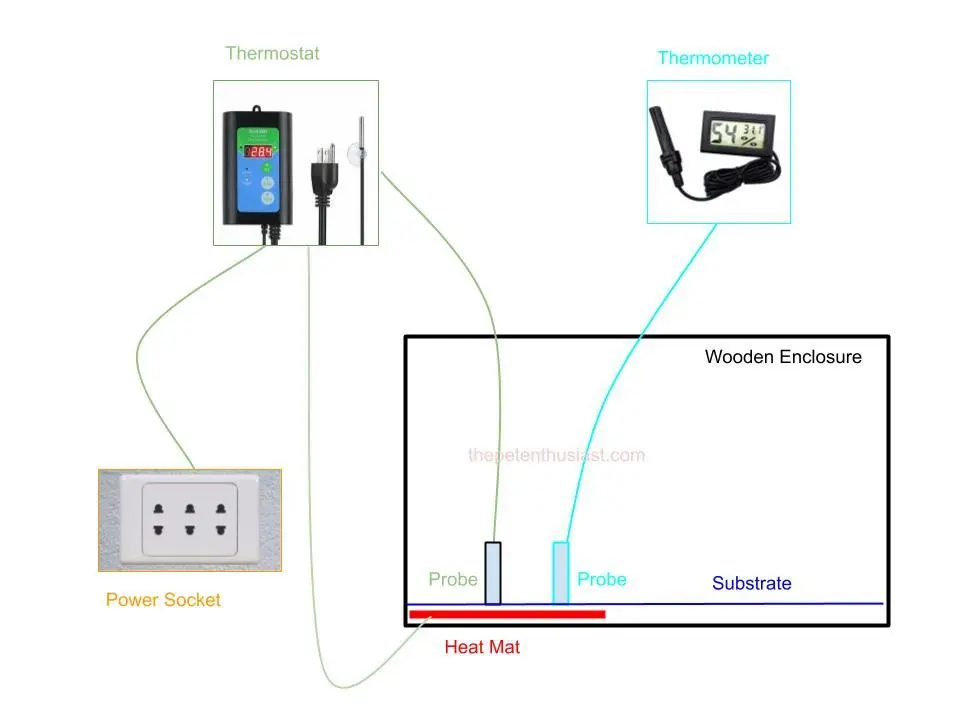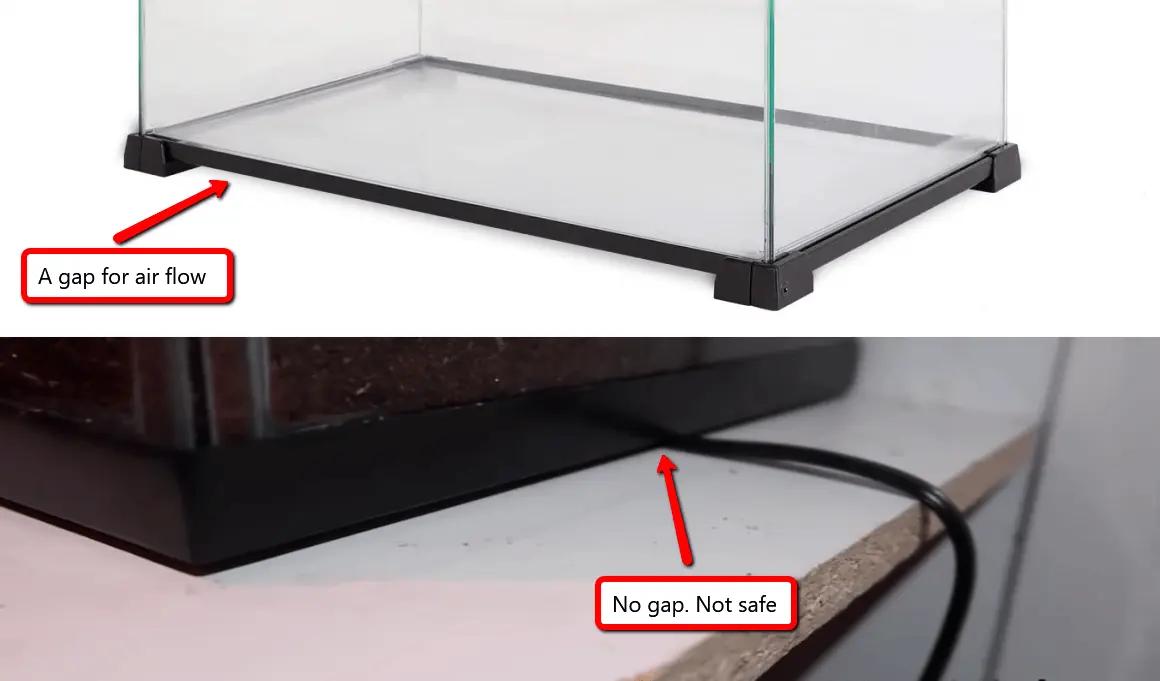Heat pads (heat mats or under tank heater) are the easy and most economical way to ensure your leopard gecko is comfortable and healthy.
Using heating pads ensures you achieve a constant temperature to help your leopard gecko stay healthy and strong.
Most of the leopard gecko heat pads on the market today are designed to fit easily under the tank, providing heat from the bottom.
These comes in a variety of sizes and from a range of top brand names.
These are an economical solution to consider when looking to heat your leopard gecko enclosure.
Table of Contents
Leopard Gecko Temperature Requirements
Leopard geckos are more active when there is low light.
They have very set temperature requirements, which ensures your gecko remains healthy.
They have floor, air and humidity requirements.
Leopard geckos require a cool and warm side of the tank, which enables them to regulate their body temperature effectively.
|
Area | Temperature |
|---|---|
|
Ambient temperature | 70ºF or more |
|
Cool side |
70ºF to 80ºF |
| Warm side |
88ºF to 92ºFAnything over 94ºF increases risk of burns |
These are the ideal temperatures you should focus on when setting up your leopard gecko heat mat.
Remember that if your humidity levels reach fifty percent or more, your gecko could experience a host of health issues.
Best Heat Source For Leopard Geckos
External heating can be heat pads, strips, heat rocks or overhead lighting.
Heat should always be provided on one side of the enclosure; this allows a natural temperature gradient on the other side.
Leopard geckos are night dwellers, which means that overhead heating is not as important as with other reptiles, such as the bearded dragon.
The leopard gecko requires heat from below, which allows for basking.
The warm side of the tank must cover at least one third of the floor space, allowing for a gradient in temperature to allow your leopard gecko to regulate its body temperature with ease.

Under Tank Heater
Heating mats and heating pads are the preferred choice for leopard geckos.
When using a heating pad, it is essential that you use a thermostat to ensure you secure the right temperature to reduce burning your reptile or providing a side that is cooler than required.
The BN-LINK Digital Heat Mat Thermostat Controller is a good thermostat that works with all under tank heaters.
A thermometer is also needed to keep regular checks on the temperature to ensure your leopard gecko is comfortable and happy.
Remember to use a digital thermometer instead of a traditional analog one. The digital thermometer is more accurate, easier to read.
An example of a good thermometer is the Exo Terra Digital Thermometer.
To measure temperature, heat guns are highly recommended for leopard gecko owners.
It is a tool to measure the surface’s temperature accurately without coming in contact. The owner can use it to verify quickly the temperature of any place in the tank.
Heat mats are the most effective way to provide a consistent temperature, they are also the safest.
They provide heat where the gecko can feel it and thermo regulate with ease. Thermo regulating is regulating their internal body temperature, bearing in mind that they are cold-blooded.
Heating from below helps to warm their bellies and aids with digestion and the mats do not dry out the environment.
Heat Rocks
Your leopard gecko is not going to bask like a bearded dragon and therefore heat rocks are not as effective as under tank heating.
The heat rocks have a reputation for malfunctioning and burning geckos. If they are not hot enough, they can cause a number of unwelcome health issues.
In addition to this, leopard geckos like to hide from predators while warming, which means that with a rock in place, they cannot hide, they don’t have the essential retreat that they need.
Overhead Lighting
Red bulbs, ceramic bulbs, light bulbs, and more are not recommended for use with your leopard gecko, and here is why.
These bulbs are all cast down into the tank, mimicking how the sun shines down onto the earth.
The problem is that your gecko is crepuscular, which means that he/she will come out at dawn and dusk when there is barely any sun.
In their natural habitats, the leopard gecko does not absorb their heat from above, they cannot tell there is heat from above, which can result in overheating.
They do not appreciate the light and this can result in eye damage in albino strains.
Further, overhead lighting tends to dry out the enclosure, eliminating any humidity. While these geckos come from desert areas, they need some moisture to help them shed property.
Remember these geckos shed in one piece, so they need some moisture to ensure health shed, reducing the risk of losing the tip of their tail or any toes in the process.
Considerations When Buying A Leopard Gecko Heating Pad
Size
It is recommended when it comes to buying a heat mat for your leopard gecko enclosure that it is big enough to cover one third of the floor space to allow for a temperature gradient.
There are a variety of heat pads in a wide choice of sizes. The output of the heat pad must be tested with a thermostat before you start using with your gecko.
The general rule of thumb:
|
Heat pad size |
Tank Size |
|---|---|
|
4 x 5 inch (10 x 13 cm) |
10 gallon |
| 6 x 8 inch (15 x 20 cm) |
10 – 20 gallon |
|
8 x 12 inch (20 x 30 cm) | 30 – 40 gallon |
| 8 x 18 inch (20 x 45 cm) |
50 – 60 gallon |
Wattage
You may be wondering what wattage your heat mat should be to provide the best heating for your leopard gecko. It depends on the size of the leopard gecko heat pad. The general rule of thumb:
|
Heat pad size |
Wattage |
|---|---|
|
4 x 5 inch (10 x 13 cm) |
4 W |
| 6 x 8 inch (15 x 20 cm) |
8 W |
|
8 x 12 inch (20 x 30 cm) | 16 W |
| 8 x 18 inch (20 x 45 cm) |
24 W |
Leopard Gecko Heat Mat Setup
For Glass Enclosures

With the glass enclosure, you are able to use the heat mat properly, placing it under the tank on the outside of the glass.
Take the size of the enclosure into consideration, choosing a leopard gecko heating pad that will be one third of the size, to create a warm and cold side to the tank.
Remove the wax paper from the heating pad and stick it to the underside of your glass tank.
Most of these heat pads come with food pegs, which are essential, especially when using glass tanks that don’t have any space below the tank and the table or counter surface.
The pegs can be placed in the four corners of the tank, lifting it slightly, which eliminates the risk of overheating and fire by allowing ample airflow under the tank and over the leopard gecko heat mat.
A heating pad that is too hot can crack your tank or worse, it can kill your leopard gecko.
When it comes to connecting your thermostat, it’s imperative that you don’t put your probe between the heat pad and the tank, this will give a false reading which can negatively impact the heat inside the tank.
When you have placed the heat mat under the tank, you can place your thermometer inside the tank using the probe as needed to measure the warm side, cool side and inside hides, and more.
If you purchase a tank that is already raised and you can easily slide the heat pad underneath, then the foot pegs may not be needed.
Related –Best hides for leopard gecko
For Wooden Enclosures
Leopard gecko heat mats are designed to go on the outside of the tank.
However, when working with a wooden enclosure, you will need to place the heat mat inside, which you can achieve by placing the heat pad at the bottom of the tank, you can choose which side you want to be your warm side.
Once the heat mat is installed, that will become your hot side. Remember the heating pad should cover no more than one third of the tank to allow for a temperature gradient.

Start by connecting the heat pad power cable to the heater socket, which can be found on the thermostat before you plug your thermostat in, and ensure that it is working effectively.
You will want to place substrate over the heat mat, as you don’t want your gecko to come in direct contact with the heat mat, which could result in unwelcome burns.
Never place your thermostat directly on the leopard gecko heat mat, as this will not give an accurate reading.
Rather place the probe of the thermostat on the substrate, closest to where the gecko will spend time to ensure the tank is warm enough.
From here you can arrange any dishes and decorations, ensuring you have a hot and cool side to keep your gecko happy and healthy.
Related –Best leopard gecko enclosure
Best Heat Pad For Leopard Gecko
Zacro Reptile Heat Pad

This leopard gecko heat mat is suitable for tanks up to twenty gallons. The mat measures 6” x 8” and comes in a box, which includes one heat pad, double sided tape and a manual.
Made from durable PVC material, the heat pad is a soft device, which makes it easy to fold, convenient to use and very easy to clean.
The leopard gecko heat mat is low energy offering powerful functionality, high efficiency and stable performance. It is an ideal heat source for tropical and desert reptiles, amphibians and arachnids.
Note when using the Zacros Reptile Heat Pad, it’s advisable that you connect the power to let the surface heat up before using the double-sided tape. This will provide a smoother surface to ensure better adhesion.
The Zacro Heat Pad has been designed using the highest quality heating wire to ensure stability, high performance and a longer life span.
This 8-watt heat pad relies on 120V and comes with a 1.8m wire and offers quick and easy installation.
Tikaton Reptile Heat Pad

The Tikaton Reptile Heat Pad comes two convenient sizes; 6” x 8” and 8” x 12”.
The pad has an adjustable temperature switch, but does still require a thermostat to make it easier for you to maintain the right temperature.
The kit comes with one heat pad and double-sided tape.
This pad comes with an upgraded design with powerful functionality, helping to improve your reptile’s health with confidence, ensuring the tank remains warm without the risk of burning your leopard gecko.
The Tikaton Reptile Heat Pad comes in a durable PVC that is soft and flexible, enabling you to fold it with easy.
The mat is convenient, easy to clean and energy efficient, helping you heat your reptile tank without draining your energy supply.
The mat uses a solid state nichrome heating element and high quality heating wire which ensures a stable performance at eight watts, making it very affordable to operate on a daily basis.
Ensure you plug your heat mat into the power socket before using the double-sided tape. The heat will ensure a smooth surface to provide better adhesion.
This leopard gecko heat pad offers the convenience of being temperature adjustable, being easy to clean and coming in two convenient sizes, both with high quality components.
The 6” x 8” heat pad is 8W and 120V with an IPX67 waterproof rating. The larger heat pad, the 8” x 12” is a 16W and 120V device.
Useful tips include you must always ensure your reptile does not having direct contact with the heating pad. Recommended for glass tanks only.
VIVOSUN Reptile Heating Pad

This leopard gecko heat mat helps to maintain a warm side of the tank with confidence for your reptile.
The right temperature ensures your pet remains healthy, continuing with daily activities and having a healthy appetite.
VIVOSUN have upgraded the adhesive materials that they use to ensure a more reliable produce. This adhesive offers the reduced risk of melting and separation.
These heating mats rely on high quality wiring to provide a stable performance.
They have new insulation layers and heating films, which ensures an improvement in heat transfer. The mat can hold a temperature of up to 113ºF.
This heat pad is 6” x 8” and is a 120V, 8W mat with six feet of power cord.
Ensure you turn your leopard gecko heat mat on and allow it to heat up before using the double-sided tape to stick it to the bottom of the tank.
The mat is very easy to use and clean, it heats up quickly to offer great energy efficiency. The waterproof and moisture proof design enable you to buy with confidence. Suitable for all types of reptiles, amphibians and more.
iPower Reptile Heat Pad Under Tank Terrarium

The iPower Reptile Heat Pad offers uniform heat with a new heating film with insulation it is able to increase heat transform uniformly over the entire mat, helping you achieve the desired temperature quickly and effectively.
The mat can be pasted anywhere with easy using 3M adhesive paper. It offers a very strong grip to the area to ensure optimum heat transfer. This mat is suitable for reptiles, amphibians and more.
The iPower Reptile Heat Pad comes with 4 avaialble sizes which suitable for different enclosure sizes.
Additional benefit of this heating pad is that it is waterproof and comes complete with a one year manufacturer’s warranty. It is also very easy to use, easy to clean and saves on energy.
This heating pad has been designed for use on a glass tank.
ZooMed Reptitherm Undertank Heater

The ZooMed Reptitherm Undertank Heater is a 6” x 8” heating pad that offers the ultimate in energy efficiency and versatility.
Designed for use with glass tanks, the heater is placed under the tank and has been manufactured using durable materials to ensure long term results.
Very easy to clean, the heating pad ensures your leopard gecko remains healthy and comfortable moving forward.
Enjoying glowing online reviews, this heating pad is convenience, easy to clean, is an excellent heat source providing an energy efficient solution to keeping your reptile happy.
How To Use Your Leopard Gecko Heat Mat Safely
The majority of the heat mats you find online are under tank heating devices.
The aim is to cover part of the enclosure to create a warm and cold side, which is why you want to research the top heating devices to find the one that best meets your exact requirements.
You want to achieve accurate heat in the safest manner possible with a minimal risk of burning your gecko or causing a fire.
Heat mats can be used for just about any reptile or amphibian, but there is some safety advice you will want to take on board, which includes:
Always use a thermostat – this will help you maintain the right temperature to reduce the risk of burning your gecko or causing a fire in the home.
Plug the thermostat into the heater to ensure you achieve the right temperatures – 88ºF to 92ºF.
Place the probe on top of the warm area to monitor temperature.
Glass Tanks
Ensure you use the heat pad properly. Glass tanks will use a heat mat outside the tank, ensure you check what the mat is designed for.
With this option the reptile has no direct contact with the heating mat.
Wood Tanks
For wood vivariums, you will want to use heat tape inside the tank with a barrier (which can be a liner), covered with substrate to protect the reptile and reduce the risk of direct contact.
The main concern with this is that there is a risk of your gecko touching the mat and getting a burn, but there is also the risk of the substrate you have selected catching fire.
Ensure you select your substrate with care if using a heat mat inside a wood vivarium.
Raised Bottom

Remember to leave a gap under the tank to allow ample air flow.
The gap is also effective in running the power cord for the heat pad.
A gap is essential to reduce the risk of fire.
The heat mat under a tank with no air is at an increased risk of overheating.
In addition to this, if the tank sits directly on the cord, this poses its own list of dangers including the weight can result in the heat pad failing and your gecko not getting the heat it needs.
A trapped cord can also result in the heat mat overheating and increasing its risk of being a fire hazard.
If you are using a fish tank or a vivarium with no gap underneath, then ensure you use the pegs/feet, which are often included in the heat mat box.
Monitor Temperatures
Regularly monitor your temperatures inside the tank to ensure that the heat mat is working properly.
Use a thermostat to set temperature and a thermometer or heat gun to monitor the warm area, ensuring your leopard gecko is comfortable.
Frequently Asked Questions
Q. What temperature should a leopard gecko heat mat be?
A. The floor surface temperature on the warm side should be 88ºF to 92ºF.
Q. What size of heat mat for leopard geckos?
A. The heat mat size depends on the size of your leopard gecko enclosure. A heat mat has to cover at least 1/3 of the tank floor.
Q. What wattage of the heat mat should I use for my leopard gecko enclosure?
A. The size of the mat is more important than wattage. Ensure your mat only takes up one-third of the tank size to allow for gradient heat.
Normally, the wattage depends on the heat pad size. For a 10 gallon tank, a 4 x 5 inch (4 W) heat pad can be used. For a 20 gallon tank, a 6 x 8 inch (8W) heat pad is required.
Q. Leopard gecko heat mat placement?
A. Heat mats (heat pads or under tank heaters) are designed to attach under and outside of the glass tanks. Because wooden or PVC enclosures don’t transmit heat well, heat pads can place inside of the tank.
Make sure you have a substrate to prevent direct contact between the heat cord and your leopard gecko.
Q. Should I leave my heat mat on 24/7? Should I turn off my heat mat at night?
A. Heat pads are designed to be on 24/7. They should be on all days to provide heat for your leopard gecko.
You will also want to ensure the mat can be attached to a thermostat, so you can regulate the temperature to keep your gecko comfortable and happy.
Leopard gecko heating pads are placed under the tank to increase the temperature to the desired rate. These are low output heating devices, which increase the temperature and remain energy efficient.
Q. Leopard gecko heat mat or heat lamp?
A. Heat mat is preferable as leopard geckos require belly heat.
Conclusion
Your main focus is to ensure you provide the warmth your reptile needs in the easiest and most affordable way.
Running a heating pad for your leopard gecko will not make a sizable impact on your energy bill.
Pay attention to providing the best habitat for your leopard gecko by making use of a heating pad to ensure you maintain internal temperature moving forward.